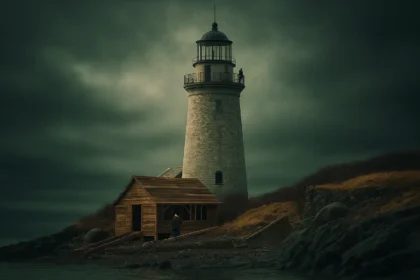One Night, Three Men, and the Void
The disappearance of the Flannan Isles lighthouse keepers in December 1900 echoes like a muffled thunderclap across the North Atlantic. When the tender vessel Hesperus arrived at the Eilean Mòr lighthouse on December 26, Commander James Harvey immediately noticed an unmistakable sign of danger: the light had been off for days. As the crew landed, they found the door locked from the inside, beds neatly made, dishes cleaned, a meal untouched on the table — and only two of the three heavy storm coats missing from the rack. Nothing suggested a planned abandonment; everything pointed to a hasty departure. Thomas Marshall, James Ducat, and Donald MacArthur were never seen again.
Discover more curiosities
- Why Is It Called Tudum? The Origin of Netflix’s Sound
- Explanation of Bête Noire in Black Mirror: Understand Everything
- Difference Between the Sides of the Moon Reveals Ancient Secrets
- Acquired Savants: Brain Injuries That Unlock Extraordinary Talents
The Setting: A Lighthouse at the End of the World

The Flannan Isles — or Seven Hunters — are gray rocky outcrops 30 km off the coast of Lewis, Scotland. Built in 1899, the lighthouse stands atop a 200-foot cliff swept by waves that can reach 30 meters in winter. There was no radio; communication relied on light signals and a logbook collected biweekly by boat. Routine was meticulously timed: monitor the lamp, log wind, tide, barometric pressure — and above all, keep the flame alive.
Living for weeks without human contact demanded rigid discipline and strong nerves. Marshall, Ducat, and MacArthur were all seasoned. Even so, the lighthouse operated on a four-man rotation: three on the island, one on shore leave. That fortnight, the fourth keeper, Joseph Moore, awaited his return in Breasclete.
Final Records: Omen of a Storm

The diary left behind, illustrative image.
The lighthouse log — found in perfect condition — recorded on December 12:
“Cyclonic gale. Sea raging, crashing over the rocks. We all prayed together.”
On December 13, the tone shifted:
“Storm still fierce, but light operational. Ducat silent, Marshall anxious, MacArthur cried — something I’ve never seen.”
December 14 included only barometer readings and morning task summaries. The space for the night shift of the 15th was blank; in its place, a slate board showed pressure and temperature figures scribbled hastily, as if awaiting transcription.
Curiously, this sequence of “cyclonic gale” doesn’t appear in weather reports from neighboring islands, raising questions: was this a localized microstorm — or a reflection of the keepers’ emotional state?
Robert Muirhead’s Inspection

Inspection by Robert Muirhead. Illustrative image.
Robert Muirhead, superintendent of the Northern Lighthouse Board, arrived days later to investigate. He found the clock stopped at 9 a.m., the lamp refilled and clean. On the western platform, a twisted iron railing, a torn winch rail, and a nearly one-ton stone displaced 30 meters downhill revealed evidence of a colossal maritime impact. More intriguing: a lifeline rope, fixed 34 meters above sea level, had been ripped away like straw.
Weighing the evidence, Muirhead concluded that an extraordinary wave had swept the platform, perhaps while one man was inspecting damage. A second might have descended to help, followed by a third without his coat — explaining the forgotten garment. Few believed three seasoned professionals would all break the rule of never leaving the lighthouse unattended. Still, this theory gained traction due to lack of better alternatives.
Theories That Still Endure

Unexpected giant wave. Illustrative image.
Over a century later, the disappearance of the Flannan Isles lighthouse keepers continues to spark speculation. The case remains unsolved, but several hypotheses have endured:
- Unexpected Rogue Wave
The most accepted theory: while securing supply crates, an abnormal wave swept over the steps and engulfed all three. Modern studies confirm that rogue waves can reach 20 meters even in moderate seas. - Rockfall or Cliff Collapse
The displaced boulder suggests a cliffside fracture. A larger slab could have collapsed, flinging debris and spray onto the platform, knocking the men off. - Internal Conflict
Old rumors suggest a disagreement, but there’s no sign of struggle or previous disciplinary records. All had reputations for sobriety. - Psychological Phenomenon
Prolonged isolation can trigger auditory hallucinations (wind effects on the structure) and extreme anxiety. A fright might have led to impulsive decisions — yet nothing explains why the sea never returned a single body.
Cultural and Familial Legacy

The Vanishing movie poster.
The story made waves in literature. In 1912, Wilfrid Wilson Gibson published the poem Flannan Isle, popularizing the image of the untouched meal and the ajar door. In 2018, the film The Vanishing dramatized the mystery, and scholars connect the claustrophobic paranoia of The Lighthouse (2019) to Eilean Mòr.
Yet for the families, the mystery never closed. Mary Ducat raised four children alone; the men’s death certificate in Carloway bears the terse note: “Probably drowned.” To this day, descendants visit the Lighthouse Keepers’ Memorial in Lewis.
The Lighthouse After the Disappearance
Since then, the lighthouse got radio in 1925, shortening the isolation. Later, in the 1970s, it was automated, eliminating the need for on-site staff. Today, cameras monitor the site, but the keepers’ house remains empty, echoing with voices the wind may have carried away.
Final Reflections
More than 120 years have passed, yet the disappearance of the Flannan Isles lighthouse keepers reminds us that both the sea — and the human mind — hold silent depths. Still, we may never know whether it was a lone wave, a rockfall at the wrong moment, or a brave misstep that caused three experienced men to vanish into mist and foam.
Mysteries like this persist not only due to the absence of answers, but because they expose the fragile line between human control and nature’s untamable force. When the lighthouse goes dark and no witnesses remain, all we can do is tell the story — and wonder what happened between the final journal entry and the first minute of darkness.
A lit beacon, then silence. A meal served but never eaten. Three men lost to time — leaving only wind, stone… and silence.
Posts Recomendados
Carregando recomendações...



